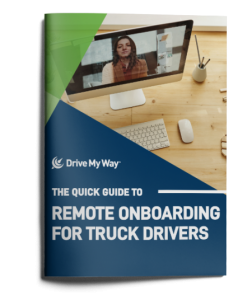
Nearly every truck driver can tell a story about taking a job with a company that does not provide them with the tools and resources they need to be successful. Whether it’s poorly maintained trucks or a confusing onboarding process, there are some clear indicating factors that will impact a company’s driver retention rate. Truck driving is already a stressful occupation, which is why drivers will not hesitate to change companies if they feel their needs are not being met.
To ensure that your company has a strong driver retention rate, you should set your drivers up for success from the moment they first apply to work for you.
Clear Application & Onboarding Processes: Long applications, lack of response, or being treated like a number are several reasons drivers have cited about why they decided to join another company. To keep quality drivers, you must first be able to hire and onboard them successfully, which is why this step is so critical. Work with your recruiting department to ensure that there are clear goals about responding to drivers in a timely manner, making them feel welcome, and following up regularly during the process. Solid communication during this initial phase of employment lays the foundation for the drivers’ experience with your company as a whole. It is also advisable to have a driver mentor program to help facilitate a new driver’s experience once they join the team.
Set Realistic Delivery Goals: Once drivers have joined your team there are several areas that they may run into issues while working, but we have noticed the top one is related to delivery. Many shipping companies set timelines that are extremely tight providing truck drivers with little room for error. Delivery times can be impacted by many factors including traffic and weather, so it is important to give drivers some flexibility to account for unexpected events. The last thing your company needs is drivers driving recklessly to meet tight deadlines.
Providing Resources for Mental & Physical Health: Truck driving takes a toll on a person’s body both mentally and physically, which is why providing resources for your drivers is a key way to help set them up for success. Health issues common amongst truck drivers include stress, high blood pressure, obesity, depression, lack of sleep, and more. To mitigate these issues, it is worth providing benefits that allow drivers to take better care of their health including insurance, gym memberships, schedules that allow for sufficient rest, and paid time off. Companies can also provide equipment to help trucks become more comfortable including seat cushions which provide lumbar support.
Balance Home Time with Time on the Road: Another way companies can help drivers be more successful and lead a healthier, happier life is by balancing time at home, with time on the road. As mentioned above, depression is one of the biggest issues facing truck drivers today and it is largely due to the amount of time spent alone. To help your drivers combat loneliness, it is important to make sure their schedule does not keep them away from home for weeks at a time and that they have plenty of breaks to communicate with their families.
Regularly Maintain Trucks & Equipment: Deliveries are only possible if drivers can arrive at their destination safely and without issue. Drivers are often faced with trucks and other equipment that is not functioning properly. To ensure your team is able to do their jobs successfully, maintaining trucks and equipment regularly is a must.
The market for experienced and quality truck drivers remains competitive, which is why it is vital to consider new and innovative ways to increase driver retention. For more tips on how to increase driver retention, make sure to check out our blog for employers regularly.




 Driver orientation and onboarding is about more than information sharing from your company. It’s also when drivers meet their peers and supervisors. It’s hard to replace this kind of natural networking in remote onboarding. Video calls, social networks, and personal phone calls or emails all help bridge the gap.
Driver orientation and onboarding is about more than information sharing from your company. It’s also when drivers meet their peers and supervisors. It’s hard to replace this kind of natural networking in remote onboarding. Video calls, social networks, and personal phone calls or emails all help bridge the gap. 







